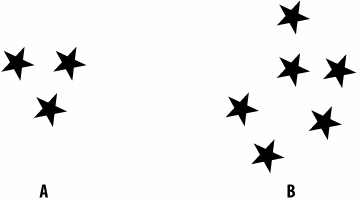Hack35.Count Faster with Subitizing
|
Hack 35. Count Faster with Subitizing
You don't need counting if a group is small enough; subitizing will do the job, and it's almost instant. The brain has two methods for counting, and only one is officially called counting. That's the regular waywhen you look at a set of items and check them off, one by one. You have some system of remembering which have already been countedyou count from the top, perhapsand then increment: 7, 8, 9... The other way is faster, up to five times faster per item. It's called subitizing. The catch: subitizing works for only really small numbers, up to about 4. But it's fast! So fast that until recently it was believed to be instantaneous. 3.3.1. In ActionSee how many stars there are in the two sets in Figure 3-3. You can tell how many are in set A just by looking (there are three), whereas it takes a little longer to see there are six in set B. Figure 3-3. The set of stars on the left can be subitized; the one on the right cannot I know this feels obvious, that it takes longer to see how many stars there are in the larger set. After it, there are more of them. But that's exactly the point. If you can tell, and it feels like immediately, how many stars there are when there are three of them, why not when there are six? Why not when there are 100? 3.3.2. How It WorksSubitizing and counting do seem like different processes. If you look at studies of how long it takes for a person to look at some shapes on the screen and report how many there are, the time grows at 40-80 ms per item up to four, then increases at 250-350 milliseconds beyond that.1 Or to put it another way, assessing the first four items takes only a quarter of a second. It takes another second for every four items after that. That's a big jump. The difference between the two is borne out by the subjective experience. Counting feels to be a very deliberate act. You must direct your attention to each item. Your eyes move from star to star. Subitizing, on the other hand, feels preattentive. Your eyes don't need to move from star to star at all. There's no deliberate act required; you just know that there are four coffee mugs on the table or three people in the lobby, without having to check. You just look. It's this that leads some researchers to believe that subitizing isn't an act in itself, but rather a side effect of visual processing. We know that we are able to keep track of a limited number of objects automatically and follow them as they move around and otherwise change. Like looking at shadows to figure out the shape of the environment [Hack #20], object tracking seems to be a built-in feature of visual processingan almost involuntary ability to keep persistent files open for objects in vision [Hack #36] . The limit on how many objects can be tracked and how many items can be subitized is curiously similar. Perhaps, say some, the reason subitizing is so quick is that the items to be "counted" have already been tagged by the visual processing system, and so there's no further work required to figure out how many there are .2 In this view, counting is an entirely separate process that occurs only when the object tracking capacity is reached. Counting then has to remember which items have been enumerated and proceed in a serial way from item to item to see how many there are. Unfortunately, there's no confirmation of this view when looking at which parts of the brain are active while each of the two mechanisms is in use.1 Subitizing doesn't appear to use any separate part of the brain that isn't also used when counting is employed. That's not to say the viewpoint of fast subitizing as a side effect is incorrect, only that it's still a conjecture. Regardless of the neural mechanism, this does give us a hint as to why it's quicker to count in small clusters rather than one by one. Say you have 30 items on the table. It's faster to mentally group them into clusters of 3 each (using the speedy subitizing method to cluster) and slowly count the 10 clusters, than it is to use no subitizing and count every one of the 30 individually. And indeed, counting in clusters is what adults do. 3.3.3. In Real LifeYou don't have to look far to see the real-life impact of the speed difference between sensing the quantity of items and having to count them. Some abaci have 10 beads on a row. These would be hardand slowto use if it weren't for the Russian design of coloring the two central beads.3 This visual differentiation divides a row into three groups with a top size of four beadsperfect for instantly subitizing with no need for actual counting. It's a little design assistance to work around a numerical limitation of the brain. We also subitize crowds of opponents in fast-moving, first-person shooter video games to rapidly assess what we're up against (and back off if necessary). The importance of sizing up the opposition as fast as possible in these types of games has the nice side effect of training our subitizing routines [Hack #43] . 3.3.4. End Notes
|
|
EAN: N/A
Pages: 159